
Eagle-Head
Printed From: History Community ~ All Empires
Category: Regional History or Period History
Forum Name: Ancient Mediterranean and Europe
Forum Discription: Greece, Macedon, Rome and other cultures such as Celtic and Germanic tribes
URL: http://www.allempires.com/forum/forum_posts.asp?TID=31314
Printed Date: 29-May-2024 at 00:54
Software Version: Web Wiz Forums 9.56a - http://www.webwizforums.com
Topic: Eagle-Head
Posted By: Ollios
Subject: Eagle-Head
Date Posted: 07-Mar-2012 at 01:57
|
Is this eagle-head guy Zeus? If yes, do you know any similar example(any greek god) what is your guess? I don't know any greek statue like that. ------------- Ellerin Kabe'si var, Benim Kabem İnsandır |
Replies:
Posted By: Don Quixote
Date Posted: 07-Mar-2012 at 03:04
I had never seen such an iconography before, but the statue of Zeus in the temple in Olympia was supposed to have head an eagle's head on the staff he is holding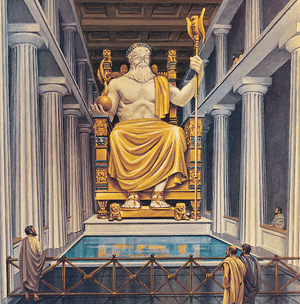 "...Within this temple the statue of the supreme god sat upon an intricately carved cedarwood throne that was decorated with mythical scenes of lesser gods and heroes rendered in gold, ebony, and precious stones. In his left hand Zeus carried a scepter made of a multicolored alloy of rare metals; crowned with an eagle's head, it symbolized his rule over the earth...." http://amazeingart.com/seven-wonders/statue-zeus.html - http://amazeingart.com/seven-wonders/statue-zeus.html So, I'd suppose that the eagle-headed guy is Zeus, but I have to research on that. It definitely drew my interest, so I'll see what I can dig up from the net. ------------- |
Posted By: TheAlaniDragonRising
Date Posted: 07-Mar-2012 at 04:11
------------- What a handsome figure of a dragon. No wonder I fall madly in love with the Alani Dragon now, the avatar, it's a gorgeous dragon picture. |
Posted By: Cyrus Shahmiri
Date Posted: 07-Mar-2012 at 05:28
That seems to be an Urupa that I talked about it in this thread: http://www.allempires.com/forum/forum_posts.asp?TID=22988 - Northeast European Tribe, Scythian
 ------------- 
|
Posted By: TheAlaniDragonRising
Date Posted: 07-Mar-2012 at 13:30
------------- What a handsome figure of a dragon. No wonder I fall madly in love with the Alani Dragon now, the avatar, it's a gorgeous dragon picture. |
Posted By: Don Quixote
Date Posted: 07-Mar-2012 at 14:07
It doesn't have wings though. This is a description of the Greek Grupa, that you mention in the above cited thread: "...Aelian, On Animals 4. 27 (trans. Scholfield) (Greek natural history C2nd A.D.) : "I have heard that the Indian animal the Grupa (Gryphon) is a quadraped like a lion; that it has claws of enormous strength and that they resemble those of a lion. Men commonly report that it is winged and that the feathers along its back are black, and those on its front are red, while the actual wings are neither but are white. And Ktesias (Ctesias) records that its neck is variegated with feathers of a dark blue; that it has a beak like an eagle's, and a head too, just as artists portray it in pictures and sculpture. Its eyes, he says, are like fire. It builds its lair among the mountains, and although it is not possible to capture the full-grown animal, they do take the young ones. And the people of Baktria, who are neighbours of the Indians, say that the Grypes (Gryphons) guard the gold in those parts; that they dig it up and build their nests with it, and that the Indians carry off any that falls from them. The Indians however deny that they guard the aforesaid gold, for the Grypes have no need for it (and if that is what they say, then I at any rate think that they speak the truth), but that they themselves come to collect the gold, while the Grypes fearing for their young ones fight with the invaders. They engage too with other beasts and overcome them without difficulty, but they will not face the lion or the elephant. Accordingly the natives, dreading the strength of these animals, do not set out in quest of the gold by day, but arrive by night, for at that season they are less likely to be detected. Now the region where the Grypes live and where the gold is mined is a dreary wilderness. And the seekers after the aforesaid substance arrive, a thousand or two strong, armed and bringing spades and sacks; and watching for a moonless night they begin to dig. Now if they contrive to elude the Grypes they reap a double advantage, for they not only escape with their lives but they also take home their freight, and when those who have acquired a special skill in the smelting of gold have refined it, they possess immense wealth to requite them for the dangers described above. And they return home, I am told, after an interval of three or four years."..." http://www.theoi.com/Thaumasios/Grypes.html - http://www.theoi.com/Thaumasios/Grypes.html This statue is nothing like the Grupa - no wings, the body is human. I'd think about some influence by Egyptian iconography, the Greeks thought that many of their gods were born in Egypt, and Amun-Ra was Zeus. But Amun wasn't potrayed with eagle head, Horus was. I have no idea what the Greeks thought Horus was, I have to check that. ------------- |
Posted By: medenaywe
Date Posted: 07-Mar-2012 at 14:27
| I believe it was Hawk on Sky!Pharaoh has snake(it's eyes shine in dark/underground sun?!) as supporter in underworld and after he defeat enemies below he flies on star sky as hawk!Yes it looks as Horus. |
Posted By: Nick1986
Date Posted: 07-Mar-2012 at 19:09
|
It also got me thinking of Horus. Ollios, where did this statue come from?
------------- Me Grimlock not nice Dino! Me bash brains! |
Posted By: okamido
Date Posted: 07-Mar-2012 at 22:33
 Padiuiset presenting incense to Rê-Horakhty-Atoum. ------------- |
Posted By: okamido
Date Posted: 07-Mar-2012 at 22:39
|
If I were to go on record for my actual thoughts on it, I would go with Ganymede as the wine-bearer for Zues. To me, the phrygian cap gives it away. ------------- |
Posted By: Don Quixote
Date Posted: 08-Mar-2012 at 02:05
|
You mean Ganymede carrying wine to Zeus who is presented with an eagle head because he abducted him in his shifted in an eagle form?The iconography of the Horus fresco you posted is the same as the one on the statue, staff and all. Considering that this is Crete, and the Greek and Egyptian tradition met there in a very literal way, it's completely possible that in the religious identification of the time Zeus was seen as Horus and Ganymede as Padiuiset - the Greeks tried to make sense out of everyone else's religion by identifying it with their own. ------------- |
Posted By: TheAlaniDragonRising
Date Posted: 08-Mar-2012 at 02:09
------------- What a handsome figure of a dragon. No wonder I fall madly in love with the Alani Dragon now, the avatar, it's a gorgeous dragon picture. |
Posted By: Ollios
Date Posted: 08-Mar-2012 at 02:11
Nice brand storming. I really enjoy to write each post

The figure is more look like Uruba than Grypes for me . In the same way there is no similar grypes figure in greek art. All of them just animal instead of Uruba  Urartu art, 99%similar Urartu art, 99%similar  Horus is another choice. Horus and Zeus always figured with staff, and in the roman period, egypt was under the huge greek colonization. I still think that it is Zeus which was created Horus style.
It is my picture from Istanbul Archaelogy Museum here is the label of the statue One of the most worst thing in the museum, there is no much information for ordinary statues. ------------- Ellerin Kabe'si var, Benim Kabem İnsandır |
Posted By: Don Quixote
Date Posted: 08-Mar-2012 at 02:40
|
"...In the rest of Egypt, however, the popularity of the cult of Amun was rapidly overtaken by the rise of the new cult of http://en.wikipedia.org/wiki/Myth_of_Osiris_and_Isis - Isis and Osiris . Outside Thebes, Amun's identity first became subsumed into Ra (Ra-Herakhty), who initially remained an identifiable figure in the http://en.wikipedia.org/wiki/Isis - Isis and http://en.wikipedia.org/wiki/Osiris - Osiris cult, but ultimately, Amun became an aspect of http://en.wikipedia.org/wiki/Horus - Horus ...." http://en.wikipedia.org/wiki/Amun - http://en.wikipedia.org/wiki/Amun So, ultimately Amun became an aspect of Horus, /since the myths and religions develop/, and since Amun was identified with Zeus by Herodotus, by the 2-3 century AD Horus would be identified with Horus. Hence, I'd go with the supposition that on the Crete statue the eagle headed guy is Zeus-Horus, presented with the regalia of Horus, and identified with him; with the priest Padiuiset identified with Ganymede. I'd think that whoever did the statue most probably dished the homoerotic aspect of the story of Ganymede, /at least there are no hits about that in it/ so the same image would speak to the Greeks about Ganymede bringing wine to Zeus; and to an Egyptian about Padiuiset making an offering to Horus. ------------- |
Posted By: Sidney
Date Posted: 08-Mar-2012 at 20:06
|
To me the phrygian cap suggests a link with Mithraism. Mithras always wore one. His was a very secretive religion, with not a great deal known about it, although it was widely practised throughout the Roman Empire.
It included certain levels of initiation, the first one being the 'Crow'. 
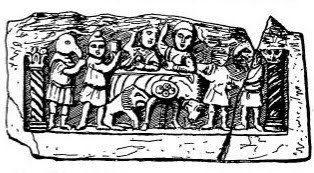
The man in the pictures above is holding a vessel very similar to the one in your picture, Ollias. The man with the Phrygian cap could be Mithras, or someone representing the initiatory rank of the 'Persian/Perseus'. The damaged figure could have a lion-head (judging by the possible remnants of hair), or maybe represented the sun - both the 'Lion/Leo' and the 'Sun/Helios' being other intiatory ranks. |
Posted By: Ollios
Date Posted: 09-Mar-2012 at 09:27
Thanks to remind Mithra. Mithraism is one of the strong cult in Roman Empire. Actually, I was thinking, how bad god is it? It is not looking like an eagle (According to roman sculpture level). If it was a crow, it must symbolise Mercury/Hermes http://en.wikipedia.org/wiki/Mithraic_mysteries - http://en.wikipedia.org/wiki/Mithraic_mysteries Staff with snake is a symbol of Mercury so do you think that there is a snake in the statue ? (there is a second thing near the staff which is held by eagle guy) ? If your answer is yes, I think we find our eagle-head( sorry crow head  ). He is Mercury ). He is Mercuryyy ------------- Ellerin Kabe'si var, Benim Kabem İnsandır |
Posted By: TheAlaniDragonRising
Date Posted: 09-Mar-2012 at 12:06
|
I don't know if this adds to it, but if indeed we're talking about a snake/serpent being in the "eagle headed" figure's grasp, then we could be talking about this being symbolic of something to do with conflict in some way, as the eagle and snake tends to be symbolic of conflict. I also notice that what is left of the figure behind that of the one seeing carrying the pot has his hand and fingers pointing downwards, a sign of death, or something being dead. Does any one know if this has anything to do with Christianity in anyway? I'm only asking because of the rose between the figures, being known as being of symbolic of Mary.
------------- What a handsome figure of a dragon. No wonder I fall madly in love with the Alani Dragon now, the avatar, it's a gorgeous dragon picture. |
Posted By: Sidney
Date Posted: 09-Mar-2012 at 12:39
|
Thanks for posting the larger pictures Ollias. It looks more like a lion-headed figure on the right to me now, and something like a bull or a sheep is standing in the background of the man with the pot. Also the bird-headed figure is holding what looks like a peacock-head in his hand, and that he may have another figure stood next to him (of which you can see some drapery). The peacock is a symbol of Persia, where Mithraism came from. I would definately look in that direction, rather than Egyptian or Christian religion (although there is some overlap between all three).
However, thanks to the enlargement, it also looks like the left arm of the man with the hat, and the body of the vessel, has been restored, and the right arm, upper body and whole head of the bird-man figure looks suspiciously new, as if it has been restored/recut. Is this so, and if so, how accurate is the later reconstruction? |
Posted By: Nick1986
Date Posted: 09-Mar-2012 at 19:53
|
What's he holding in his hand?
------------- Me Grimlock not nice Dino! Me bash brains! |
Posted By: Sidney
Date Posted: 09-Mar-2012 at 20:19
|
Which he?
|
Posted By: Nick1986
Date Posted: 09-Mar-2012 at 20:32
The eagle-headed person on the left ------------- Me Grimlock not nice Dino! Me bash brains! |
Posted By: Sidney
Date Posted: 09-Mar-2012 at 20:52
|
A staff, but also something with a bird's head. I thought it was a peacock's head, but not sure the feathers don't look right.(But could be stylised).
Looks most like a cockateel. But cockateels are native to Australia!! Any bird buffs able to identify the profile? 
|
Posted By: Ollios
Date Posted: 10-Mar-2012 at 01:01
I am asking that too? There have been a crown guy in Mithraism, who has bird head and caduceus (staff with snakes). I think second thing near the staff, is a snake. Am I right? I am seeing an eye on it or I am tring to fit it  . If it is a caducues, I think there is no need to discuss. According to that theory, guy is Mithra and the crow headed guy is Hermes. . If it is a caducues, I think there is no need to discuss. According to that theory, guy is Mithra and the crow headed guy is Hermes. for crow headed guy look (it explains every symbolic person in Mithraism) http://en.wikipedia.org/wiki/Mithraic_mysteries#Degrees_of_initiation - http://en.wikipedia.org/wiki/Mithraic_mysteries#Degrees_of_initiation ------------- Ellerin Kabe'si var, Benim Kabem İnsandır |
Posted By: Don Quixote
Date Posted: 10-Mar-2012 at 01:10
|
There are cockatoos in Africa, with similar plumage. But I have to admit that I never read anything about cockatoos holding symbolic value in Egypt of the Mediterranean. http://www.exploringnature.org/db/detail.php?dbID=41&detID=2115 - http://www.exploringnature.org/db/detail.php?dbID=41&detID=2115 Whatever the figure in question is, it doesn't look like a snake to me. ------------- |
Posted By: medenaywe
Date Posted: 10-Mar-2012 at 02:41
But there are falcon(hawk)&Egyptian cobra snake.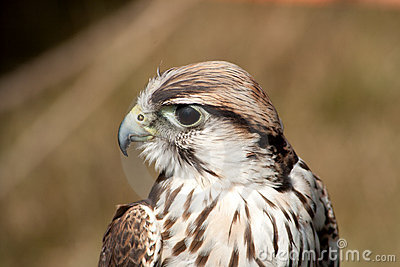 |
Posted By: Sidney
Date Posted: 10-Mar-2012 at 08:57
|
Yes, but the bird head definately has a crest that falls down behind its neck. I don't think falcons/hawks do - unless you can provide a picture. It could also be a divine/mythic bird with no relation to an actual species, but it would be nice to find another example to compare it to.
Could be that the small bird head is a smaller version of the bird-man's head. The man could have a lowered crest of feathers down near his shoulders. Ollios - have you seen the sculpture from a different angle? Can you tell us something about the ground area of the figures (ie their feet - type of footware if any, any plants/animals?). The staff seems to bifercate in the palm of the bird-man's hand. Its an odd shape for a staff to take. Anybody seen anything similar? |
Posted By: Sidney
Date Posted: 10-Mar-2012 at 09:36
Found this picture on the 'net -
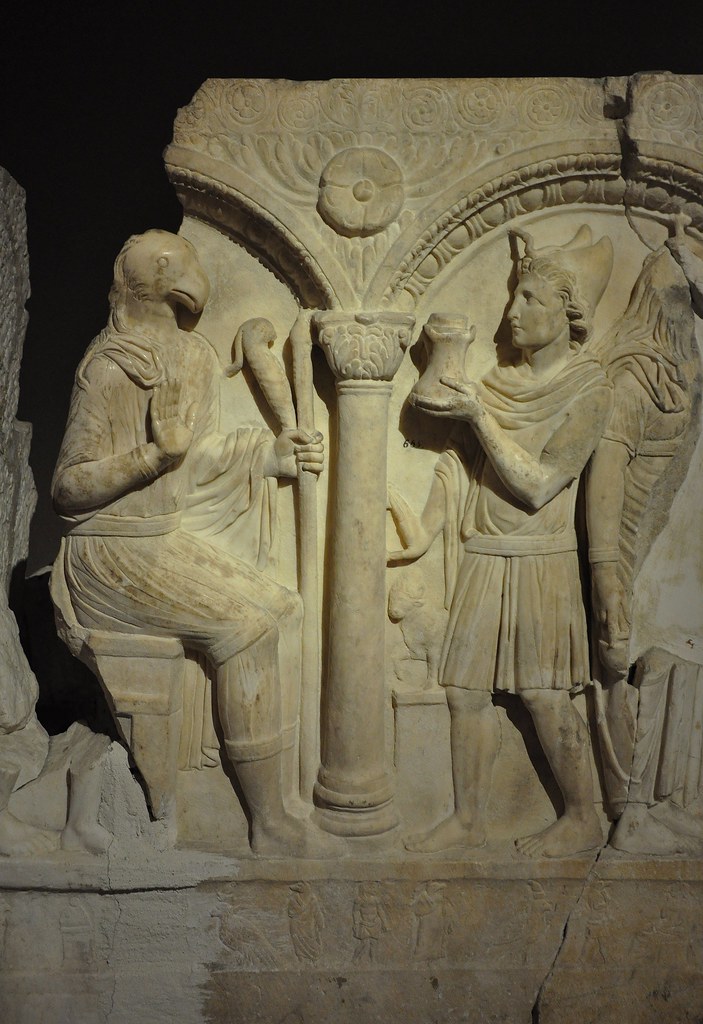
And this website with more detailed images; http://www.pbase.com/dosseman/image/92098499 - http://www.pbase.com/dosseman/image/92098499 including; 
The website above says the sculpture could be identified thus; "The 1935 Guide of the Museum mentions a fragment from a sarcophagus from Hierapytna in Crete from the II century AD where Horus with a hawk head and long hair is seated in one of the niches. In his right hand he holds a scepter and the sacred uraeus, symbols of his sacred nature and kingship. To his right a young worshipper heads to the god. On his head a double tip cap with an uraeus too. Next to the young man a small Apis bull with the sun disc between its horns. Next to him stands Isis. The long left side contains additional scenes. The sarcophagus is said to be the work of a Greek sculptor who clumsily reproduced Egyptian scenes that he did not fully understand. The four sides of the sarcophagus depicted scenes of worshipping of Horus, Isis and Osiris by a young man and a woman, likely aimed at portraying those buried within." The figures along the base definately give this an Egyptian background to design. But the above description is only the cataloguer's interpretation. I don't think those are uraeus' represented, nor do I think that it is a female figure behind the man in the hat. Nor do I think it was a clumsy sculpture - the smaller figures on the base are easily identified as Egyptian gods. And there is a unidentified fourth figure behind the bird-man. I still feel there could be a Mithraic elements in the main sculpture, and that there are some interesting, unanswered elements in the piece that are worth pursuing and discussing. 
|
Posted By: medenaywe
Date Posted: 10-Mar-2012 at 09:48
Falcon hood always has a crest Sidney: It makes bird beautiful with character! It makes bird beautiful with character!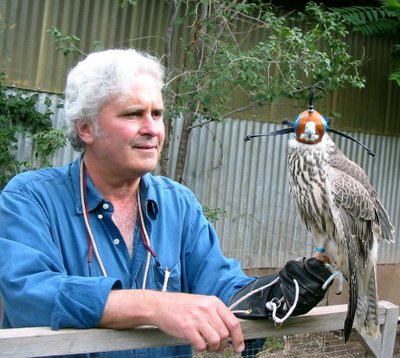 |
Posted By: Sidney
Date Posted: 10-Mar-2012 at 10:01
Show me one that looks like the sculpture, and I'll agree with the comparison. [And off topic - IMHO it is not beautiful:its like a ring in a bulls nose, putting a muzzle on a bear or docking a dogs tail; its a symbol of human dominance and utilization of nature.] |
Posted By: Ollios
Date Posted: 10-Mar-2012 at 10:29
Well done Sidney, you can be great researcher. I have to accept that theory unless Museum authorites changes its table or we find more trustable source about it. ------------- Ellerin Kabe'si var, Benim Kabem İnsandır |
Posted By: Sidney
Date Posted: 10-Mar-2012 at 12:56
| There is no need to accept all of it. It is just one interpretation, that doesn't really answer all the questions. |
Posted By: Don Quixote
Date Posted: 10-Mar-2012 at 13:53
|
I don't agree with the interpretation of the catalogue - what does it mean "Represented Egyptian scene that he didn't understand?" It's us who don't understand it, because the knew for it's understanding was lost along the flow of time and cultures, not the person who did the work and key what he was doing. In ancient time making sculptures wasn't an art for the art of it, in the way we are seeing it now - it was or sacred work, in which the sculptor followed the iconography of his time and culture; or decorative work, like the Roman did Greek copies and put them in their homes; in the both cases whoever did the statue was a craftman, repeating iconographic convention, not imagining stuff. Every religious representation was seen as sacred, the gods literally inhabiting it too, that's why statues of gods were fed, clothed, etc; to misrepresent a divinity wouldn't bring the desired effect of whatever the ones who represent it were seeking. My opinion is that this is definitely work that resulted from fusion of religious ideas, identifying the gods in one culture with the gods from another one - something that the Greeks were doing all the time not only with Egyptian gods, but with Anatolian and Thracian ones - some Greek cities were worshiping the Thracian Cotys, identified with Demeter, or Persephone; and the Thracian Sabazius was identified with Dionysus. But I had never researched Mitraism, and it's possible influence in Greece or Egypt, so unless I unless I dig some good articled on that I'm going to be speaking unprepared, which I rather not do. So far I see the work as a product of Greko-Egyptian religious fusing, /with the representation of Horus and his priest being the closest to the Cretan one/, with Horus identified with Zeus. I can agree on the bird being a hawk, since it makes more sense in symbolic way, but it doesn't look like a cobra to me. Here is an Egyptian cobra-iconography:
------------- |
Posted By: Nick1986
Date Posted: 10-Mar-2012 at 20:29
Could the "crest" actually be the snake's tongue? ------------- Me Grimlock not nice Dino! Me bash brains! |
Posted By: Don Quixote
Date Posted: 10-Mar-2012 at 20:46
|
Where is the crest? I looked at bunch of picts of "uraeus" here http://www.google.com/search?q=uraeus+picture&hl=en&client=firefox-a&hs=9Xt&rls=org.mozilla:en-US:official&prmd=imvns&tbm=isch&tbo=u&source=univ&sa=X&ei=YAJcT_X5MsiTiQKt09XBCw&ved=0CCcQsAQ&biw=1366&bih=613 - http://www.google.com/search?q=uraeus+picture&hl=en&client=firefox-a&hs=9Xt&rls=org.mozilla:en-US:official&prmd=imvns&tbm=isch&tbo=u&source=univ&sa=X&ei=YAJcT_X5MsiTiQKt09XBCw&ved=0CCcQsAQ&biw=1366&bih=613 and found this one, from Lower Egypt, after 600 BC http://www.historyplace.com/specials/slideshows/mummies/mummies6.htm - http://www.historyplace.com/specials/slideshows/mummies/mummies6.htm : 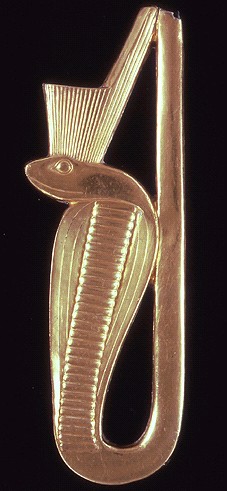 Snake with plumage! Not only this but his tail pucks up above his head. So I though - can the "plumed bird" be a plumed snake, and his "plume" actually to be his tail hanging down? This would explain where the body of the snake is /curled behind the upper part of his body/. ------------- |
Posted By: okamido
Date Posted: 11-Mar-2012 at 20:10
|
If that animal beside the cup-bearer is in fact a bull and not a sheep, then I will have to go with the egyptian interpretation rather than my initial belief that it was tied to Ganymede. ------------- |
Posted By: Don Quixote
Date Posted: 11-Mar-2012 at 20:56
|
I don't see horns on the animal, and it looks like a lamb to me, having curly hair. Sheep were sacrificed to Zeus: "... http://www.perseus.tufts.edu/cgi-bin/ptext?lookup=Dem.+21+53 - Demosthenes, Speech 21, 21.53 - Demosthenes instructs the people to sacrifice “to Zeus of the Ship . . . three oxen and with each ox three sheep.” http://www.perseus.tufts.edu/cgi-bin/ptext?lookup=Hom.+Il.+3.76 - Homer Iliad Book 3.104 - The sacrifice of a black ewe to Zeus. http://ablemedia.com/ctcweb/consortium/ancientolympianszeus8.html - http://ablemedia.com/ctcweb/consortium/ancientolympianszeus8.html If the scene depicts a priest who brings libations to Zeus/Horus, then the lamb can be brought as a sacrificial animal. ------------- |


